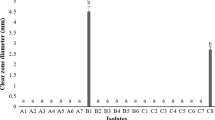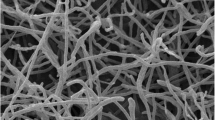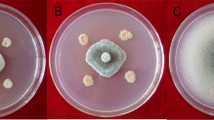Abstract
Sour rot caused by Geotrichum citri-aurantii is a serious postharvest disease of citrus that can result in devastating economic losses. In this study, a new bacterial strain, WE-3, was isolated from soil samples of orchards at Huazhong Agricultural University and then screened in vitro to investigate its antifungal activity against G. citri-aurantii. Bacterium WE-3 was characterized as a member of the Bacillus family by physiological, biochemical, and 16S ribosomal gene analyses. The culture filtrate from strain WE-3 could effectively restrain the expansion of G. citri-aurantii in citrus after 6 d of artificial inoculation. Scanning electron microscopy examination showed that the WE-3 culture filtrate-treated G. citri-aurantii spores were morphologically longer and smoother. The expression of two chitin synthase-related genes and a redox-related gene remained downregulated when G. citri-aurantii was incubated with the WE-3 culture filtrate. Meanwhile, cellular content leakage was accompanied by cell vacuolation of the culture filtrate-treated G. citri-aurantii cells upon transmission electron microscopy examination. Finally, culture filtrate-handled citrus fruit exhibited similar physiological qualities to distilled water-handled fruit. Our study reveals that bacterial strain WE-3 might be a potent biological control agent against G. citri-aurantii in citrus.






Similar content being viewed by others
References
Ambrico, A., & Trupo, M. (2017). Efficacy of cell free supernatant from Bacillus subtilis ET-1, an Iturin a producer strain, on biocontrol of green and gray mold. Postharvest Biology and Technology, 134, 5–10.
Brown, G. E. (1988). Efficacy of guazatine and iminoctadine for control of postharvest decays of oranges. Plant Disease, 72, 906–908.
Butler, E. E., Fogle, D., & Miranda, M. (1988). Galactomyces citri-aurantii, a newly found teleomorph of Geotrichum citri-aurantii, the cause of sour rot of citrus fruit. Mycotaxon -Ithaca Ny, 33, 197–212.
Chen, K., Tian, Z., He, H., Long, C. A., & Jiang, F. (2020). Bacillus species as potential biocontrol agents against citrus diseases. Biological Control, 151, 104419.
Chen, K., Tian, Z., Luo, Y., Cheng, Y., & Long, C. A. (2018). Antagonistic activity and the mechanism of Bacillus amyloliquefaciens DH-4 against Citrus green Mold. Phytopathology, 108, 1253–1262.
Chen, X., Wang, Y., Gao, Y., Gao, T., & Zhang, D. (2019). Inhibitory abilities of Bacillus isolates and their culture filtrates against the gray Mold caused by Botrytis cinerea on postharvest fruit. Plant Pathology Journal, 35, 425–436.
Chowdhury, S.P., Hartmann, A., Gao, X.W., Borriss, R., (2015). Biocontrol mechanism by root-associated Bacillus amyloliquefaciens FZB42-a review. Frontiers in Microbiology, 6, 780.
Droby, S., Wisniewski, M., Macarisin, D., & Wilson, C. (2009). Twenty years of postharvest biocontrol research: Is it time for a new paradigm? Postharvest Biolody and Technology, 52, 137–145.
Droby, S., Wisniewski, M., Teixido, N., Spadaro, D., & Jijakli, M. H. (2016). The science, development, and commercialization of postharvest biocontrol products. Postharvest Biology and Technology, 122, 22–29.
Ferraz, L. P., da Cunha, T., da Silva, A. C., & Kupper, K. C. (2016). Biocontrol ability and putative mode of action of yeasts against Geotrichum citri-aurantii in citrus fruit. Microbiological Research, 188, 72–79.
Ippolito, A., & Nigro, F. (2000). Impact of preharvest application of biological control agents on postharvest diseases of fresh fruits and vegetables. Crop Protection, 19, 715–723.
Jangir, M., Pathak, R., Sharma, S., & Sharma, S. (2018). Biocontrol mechanisms of Bacillus sp., isolated from tomato rhizosphere, against fusarium oxysporum f. sp. lycopersici. Biological Control, 123, 60–70.
Kakembo, D., & Lee, Y. H. (2019). Analysis of traits for biocontrol performance of Pseudomonas parafulva JBCS1880 against bacterial pustule in soybean plants. Biological Control, 134, 72–81.
Karim, H., Boubaker, H., Askarne, L., Talibi, I., Msanda, F., Boudyach, E. H., Saadi, B., & Ben Aoumar, A. A. (2015). Antifungal properties of organic extracts of eight Cistus L. species against postharvest citrus sour rot. Letters in Applied Microbiology, 62, 16–22.
Kefialew, Y., & Ayalew, A. (2008). Postharvest biological control of anthracnose (Colletotrichum gloeosporioides) on mango (Mangifera indica). Biological Control, 50, 8–11.
Kilani-Feki, O., Ben Khedher, S., Dammak, M., Kamoun, A., Jabnoun-Khiareddine, H., Daami-Remadi, M., & Tounsi, S. (2016). Improvement of antifungal metabolites production by Bacillus subtilis V26 for biocontrol of tomato postharvest disease. Biological Control, 95, 73–82.
Klein, M. N., & Kupper, K. C. (2018). Biofilm production by Aureobasidium pullulans improves biocontrol against sour rot in citrus. Food Microbiology, 69, 1–10.
Kumar, S., Stecher, G., Li, M., Knyaz, C., & Tamura, K. (2018). MEGA X: Molecular evolutionary genetics analysis across computing platforms. Molecular Biology and Evolution, 35, 1547–1549.
Liu, H. M., Guo, J. H., Cheng, Y. J., Liu, P., Long, C. A., & Deng, B. X. (2010a). Inhibitory activity of tea polyphenol and Hanseniaspora uvarum against Botrytis cinerea infections. Letters in Applied Microbiology, 51, 258–263.
Liu, H. M., Guo, J. H., Liu, P., Cheng, Y. J., Wang, B. Q., Long, C. A., & Deng, B. X. (2010b). Inhibitory activity of tea polyphenol and Candida ernobii against Diplodia natalensis infections. Journal of Applied Microbiology, 108, 1066–1072.
Liu, P., Cheng, Y.J., Yang, M., Liu, Y.J., Chen, K., Long, C.A., Deng, X.X., (2014a). Mechanisms of action for 2-phenylethanol isolated from Kloeckera apiculata in control of Penicillium molds of citrus fruits. BMC Microbiology, 14, 242.
Liu, P., Fang, J. F., Chen, K., Long, C. A., & Cheng, Y. J. (2014b). Phenylethanol promotes adhesion and biofilm formation of the antagonistic yeast Kloeckera apiculata for the control of blue mold on citrus. FEMS Yeast Research, 14, 536–546.
Livak, K. J., & Schmittgen, T. D. (2001). Analysis of relative gene expression data using real-time quantitative PCR and the 2-ΔΔCT method. Methods, 25, 402–408.
McKay, A. H., Forster, H., & Adaskaveg, J. E. (2012). Efficacy and application strategies for propiconazole as a new postharvest fungicide for managing sour rot and green mold of citrus fruit. Plant Disease, 96, 235–242.
Moscoso-Ramirez, P. A., & Palou, L. (2013). Evaluation of postharvest treatments with chemical resistance inducers to control green and blue molds on orange fruit. Postharvest Biology and Technology, 85, 132–135.
Nan, J., Zhang, S., & Jiang, L. (2021). Antibacterial potential of Bacillus amyloliquefaciens GJ1 against Citrus Huanglongbing. Plants, 10, 261.
Nunes, C. A. (2012). Biological control of postharvest diseases of fruit. European Journal of Plant Pathology, 133, 181–196.
OuYang, Q. L., Duan, X. F., Li, L., & Tao, N. G. (2019). Cinnamaldehyde exerts its antifungal activity by disrupting the cell wall integrity of Geotrichum citri-aurantii. Frontiers in Microbiology, 10, 55.
Sabate, D. C., Brandan, C. P., Petroselli, G., Erra-Balsells, R., & Audisio, M. C. (2018). Biocontrol of Sclerotinia sclerotiorum (lib.) de Bary on common bean by native lipopeptide-producer Bacillus strains. Microbiological Research, 211, 21–30.
Sanzani, S. M., Reverberi, M., & Geisen, R. (2016). Mycotoxins in harvested fruits and vegetables: Insights in producing fungi, biological role, conducive conditions, and tools to manage postharvest contamination. Postharvest Biology and Technology, 122, 95–105.
Sha, Y., Zeng, Q., & Sui, S. (2020). Screening and application of Bacillus strains isolated from nonrhizospheric rice soil for the biocontrol of rice blast. Plant Pathology Journal, 36, 231–243.
Sharma, R. R., Singh, D., & Singh, R. (2009). Biological control of postharvest diseases of fruits and vegetables by microbial antagonists: A review. Biological Control, 50, 205–221.
Spadaro, D., & Droby, S. (2016). Development of biocontrol products for postharvest diseases of fruit: The importance of elucidating the mechanisms of action of yeast antagonists. Trends in Food Science and Technology, 47, 39–49.
Talibi, I., Boubaker, H., Boudyach, E. H., & Ait Ben Aoumar, A. (2014). Alternative methods for the control of postharvest citrus diseases. Journal of Applied Microbiology, 117, 1–17.
Tian, Z., Chen, C., Chen, K., Liu, P., Fan, Q., Zhao, J., Long, C., (2020). Biocontrol and the mechanisms of Bacillus sp. w176 against postharvest green mold in citrus. Postharvest Biology and Technology, 159, 111022.
Villegas-Escobar, V., Gonzalez-Jaramillo, L. M., Ramirez, M., Moncada, R. N., Sierra-Zapata, L., Orduz, S., & Romero-Tabarez, M. (2018). Lipopeptides from Bacillus sp. EA-CB0959: Active metabolites responsible for in vitro and in vivo control of Ralstonia solanacearum. Biological Control, 125, 20–28.
Xu, W., Zhang, L., Goodwin, P. H., Xia, M., Zhang, J., Wang, Q., Liang, J., Sun, R., Wu, C., & Yang, L. (2020). Isolation, identification, and complete genome assembly of an endophytic Bacillus velezensis YB-130, potential biocontrol agent against fusarium graminearum. Frontiers in Microbiology, 11, 598285.
Yang, Y., OuYang, Q., Li, L., Shao, X., Che, J., & Tao, N. (2019). Inhibitory effects of glutaraldehyde on Geotrichum citri-aurantii and its possible mechanism. Journal of Applied Microbiology, 127, 1148–1156.
Zhu, H. M. Y., & Pan, Y. Z. (2019). A novel antimicrobial protein of the endophytic Bacillus amyloliquefaciens and its control effect against Fusarium chlamydosporum. Biocontrol, 64, 737–748.
Zouari, I., Jlaiel, L., Tounsi, S., & Trigui, M. (2016). Biocontrol activity of the endophytic Bacillus amyloliquefaciens strain CEIZ-11 against Pythium aphanidermatum and purification of its bioactive compounds. Biological Control, 100, 54–62.
Acknowledgments
We thank the National Natural Science Foundation of China (Grant NO. 31972122), Science and Technology Major Project of Guangxi (Gui Ke AA17204045-4) and the Earmarked Fund of China Agriculture Research System (Grant NO. CARS-26) for financial support.
Author information
Authors and Affiliations
Corresponding authors
Ethics declarations
Conflict of interest
No conflicts of interest declared.
Ethics approval
No studies of human participants or animals were included in this manuscript.
Rights and permissions
About this article
Cite this article
Tian, Z., Li, Y., Yang, Q. et al. Antifungal activities and the mechanisms of biocontrol agent WE-3 against postharvest sour rot in citrus. Eur J Plant Pathol 161, 723–733 (2021). https://doi.org/10.1007/s10658-021-02356-y
Accepted:
Published:
Issue Date:
DOI: https://doi.org/10.1007/s10658-021-02356-y




